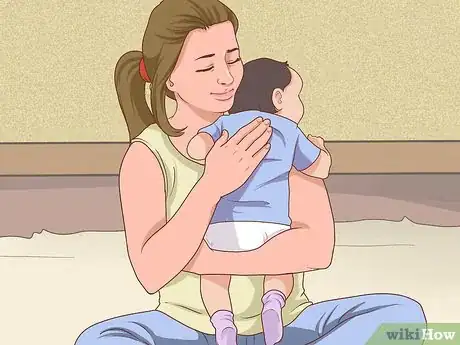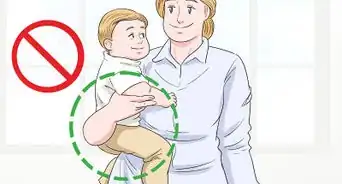This article was co-authored by Denise Stern. Denise Stern is a Parenting Specialist and the CEO of Let Mommy Sleep, the country’s leading Baby Nurse and Postpartum Care service. Denise specializes in providing nurturing care to newborns and evidence-based education to their parents. She holds a BA in Public Relations from North Carolina State University. Denise was the US Chamber of Commerce Leading Woman-Owned Business in 2013, a Washington FAMILY Magazine Mother of the Year in 2016, and on the elite White House Summit for Working Families hosted by the President and First Lady Obama in 2014. Let Mommy Sleep is the only company of its kind that holds a local government contract to teach newborn and postpartum care.
wikiHow marks an article as reader-approved once it receives enough positive feedback. This article received 17 testimonials and 100% of readers who voted found it helpful, earning it our reader-approved status.
This article has been viewed 466,229 times.
Whether you're a first-time parent holding your baby, or a proud relative snuggling the newest addition to your extended family, it's essential to learn how to hold an infant properly. There are a variety of correct ways to hold your baby, from the snuggle hold to the face-to-face hold, depending on how you want to interact with your baby. Just remember that it's important to be calm and confident before you pick up your baby, so they are relaxed before you make a connection.
Steps
Doing the Snuggle Hold
-
1Be calm and confident before picking up the baby. Babies can often sense if you're uncomfortable or upset. Relax.[1] Confidence is the key; holding a baby for the first time can be extremely terrifying for some people. You just have to remember that you can do this, and the joy of holding that baby will outweigh all of the anxieties! Though it's always important to be as careful as possible also remember: Babies are not as fragile as we think.
-
2Support the baby's head with one arm and support its bottom with the other. A newborn baby's head is by far the heaviest part of their body, and a baby's head and neck needs careful support. Usually you will hold the head gently with one hand. Use your right arm to scoop up the baby's bottom. Do this while supporting the head with your other hand.[2]Advertisement
-
3Make chest-to-chest contact. Bring the baby close to your chest, so that they can rest their head against your chest. Babies are instinctively comforted by hearing your heartbeat. Your right hand and arm should be supporting most of the baby's body weight, while your left hand supports and protects the head and neck.[3]
- Just make sure that your baby's head is facing to one side so that they can always breathe.
-
4Enjoy bonding with the baby. Holding a baby can be incredibly soothing for both you and the baby. This is a great time to sing to the baby, read to the baby, and entertain the baby until it's time for the next feeding, diaper change, or nap. You will need to switch hands from time to time. When you do this, remember to always keep one hand under the baby's head as you switch hands.
- Listen to your baby. Each baby has their own preferences for how they want to be held. If your baby is crying or being fussy, try switching to a different holding position.
Mastering Other Holding Techniques
-
1Do the cradle hold. This is perhaps the most common way to hold your baby and a great way to gaze into the new baby's eyes; it's also the most natural and easiest way to hold your baby. It's easiest to hold your baby this way when the baby is swaddled. Here's what you should do:
- To cradle hold your baby, first lay your baby down and pick it up by sliding one hand under the neck and head, and the other under the bottom and hips.
- Spread your fingers as much as you can as you lift them to your chest so you can support the baby as much as possible.
- Gently slide the hand supporting their head and neck along their back, so that their head and neck slide along your forearm, making their way into the crook of your arm and elbow.[4]
- Keep your other hand where it was, cupping your baby's hips and bottom.
- Bring the baby close to your body and gently rock their back and forth, if you like.
-
2Do the face-to-face hold. This is a great hold for interacting with your baby. Here's what you have to do to get it right:[5]
- Place one hand behind your baby's head and neck.
- Put the other hand under their bottom.
- Hold the baby out in front of you, just below your chest.
- Have fun smiling and making faces at your cute baby.
-
3Do the belly hold. This hold is perfect for calming your baby down when they are being fussy. Here's what you have to do to master this hold:[6]
- Drape your baby's head and chest over your forearm.
- Make sure that the baby's head is turned outward, resting near the crook of your arm.
- Pat or rub your baby's back with your other hand.
- Check your baby's head and neck to ensure that they are supported at all times.
-
4Do the football hold. This hold is great for feeding and can also be used whether you're standing or sitting. Here's how you do it:
- Place a hand under your baby's head and neck and rest the baby's back on the inside of the same forearm of the hand you're using to hold its head. You can use the other hand as a placeholder under the baby's head as you get adjusted, as long as you make sure that the head and neck are supported at all times.
- Have the baby curl around the side of your body, with its legs extended behind you.
- Draw the baby close to your chest or your waist.
- Use your free hand to feed the baby or give its head extra support.
-
5Do the "hello world" hold. This is a great hold if you have a curious baby and want to let it see what is going on around it. Here's all you have to do:
- Let your baby's back rest against your chest so that his head is supported.
- Place one arm under his bottom.
- Place the other arm across his chest.
- Make sure that the baby's head remains supported by your chest.
- If you're sitting down, then you can place the baby on your lap and don't need to put a hand under his bottom.
-
6Hold your baby on your hip/side when it can support its own head. Once your baby has gotten a bit older, somewhere in the 4-6 month mark, they should be able to steadily support their own head! Once your baby has achieved this, here's how you can hold him/her on your hip: (The seemingly most common hold for very young babies and toddlers alike):
- Rest the baby's side (nestled) or midsection (straddling you,) against your side/hip. Be sure to rest the baby's left side or midsection against your right side/hip; or vice versa, depending on which side you wish to hold the baby. Make sure that no matter which side you hold the baby on, you ensure that the baby's head faces outward. (Refer to the photograph above. The mother is holding the baby on her right side/hip, From the baby's left side (straddling) with the baby's head facing forward.)
- Use the arm of your "holding" hip/side to support the baby's legs and back. Add support firmly, yet comfortably, for you and the baby.
- You can use your free hand for extra support under the baby's legs, back, bottom or wherever else the baby may need extra support. You can also use this hand to feed your baby or perform other necessary tasks (so long as the baby does not need extra support and you feel very comfortable with this hold.)
- This hold is very common, important and convenient; especially when you have to multitask. Take time to master this hold, use it safely and I promise, you will be very glad that you did.
Community Q&A
-
QuestionHow do I hand a newborn over to someone while supporting the baby's head?
 Community AnswerKeep your hand under the baby's head and and slowly remove your other hand whilst the person you're handing it over rests her hand in their same way you had done seconds ago. Once one hand is firmly on their baby, then she should put her hand on top of yours where it's placed on the baby's head and then gradually remove your hand.
Community AnswerKeep your hand under the baby's head and and slowly remove your other hand whilst the person you're handing it over rests her hand in their same way you had done seconds ago. Once one hand is firmly on their baby, then she should put her hand on top of yours where it's placed on the baby's head and then gradually remove your hand. -
QuestionHow do I carry a 9-month-old baby up and down the stairs?
 Community AnswerUse the method where he is straddled on your hip. Then wrap your arm around to his back.
Community AnswerUse the method where he is straddled on your hip. Then wrap your arm around to his back. -
QuestionHow do I hold a baby if it is fussy and I am a kid?
 Community AnswerDo your best to comfort them. If you can't then they probably don't want to be held.
Community AnswerDo your best to comfort them. If you can't then they probably don't want to be held.
Warnings
- Shaking or other sudden movements can harm the baby.⧼thumbs_response⧽
- Don't hold a baby while handling hot liquids, food, or while cooking.⧼thumbs_response⧽
- Failing to support the baby's head can cause permanent injury.⧼thumbs_response⧽
- Holding a baby in the up-right position (tummy-to-tummy) when the baby cannot sit for themselves can cause damage to the baby's spine.⧼thumbs_response⧽
References
- ↑ https://parenting.firstcry.com/articles/learn-how-to-hold-a-newborn-baby/
- ↑ https://raisingchildren.net.au/newborns/health-daily-care/holding-newborns/how-to-hold-your-newborn
- ↑ https://raisingchildren.net.au/newborns/health-daily-care/holding-newborns/how-to-hold-your-newborn
- ↑ https://parenting.firstcry.com/articles/learn-how-to-hold-a-newborn-baby/
- ↑ https://parenting.firstcry.com/articles/learn-how-to-hold-a-newborn-baby/
- ↑ https://www.happiestbaby.com/blogs/baby/how-to-hold-a-baby
- http://www.babycenter.com/2_how-to-hold-a-baby_10368219.bc
- http://www.artofmanliness.com/2013/12/11/new-dad-survival-guide-the-skillset/
About This Article
To hold a baby, use your hand to cradle the baby’s head, then use the other hand to scoop up the baby’s bottom. Gently lift the baby up to your chest so that their head is resting on you. Keep your hand on the baby’s head to support their neck, and make sure that their face is turned to the side so they can breathe. Once you are confident in holding a baby, you can try picking them up the same way, but holding the baby out in front of you instead of letting them rest on your chest, so that you can interact with them. Keep reading the article if you want to learn more, like how to support a baby on your hip, keep reading the article!








































































